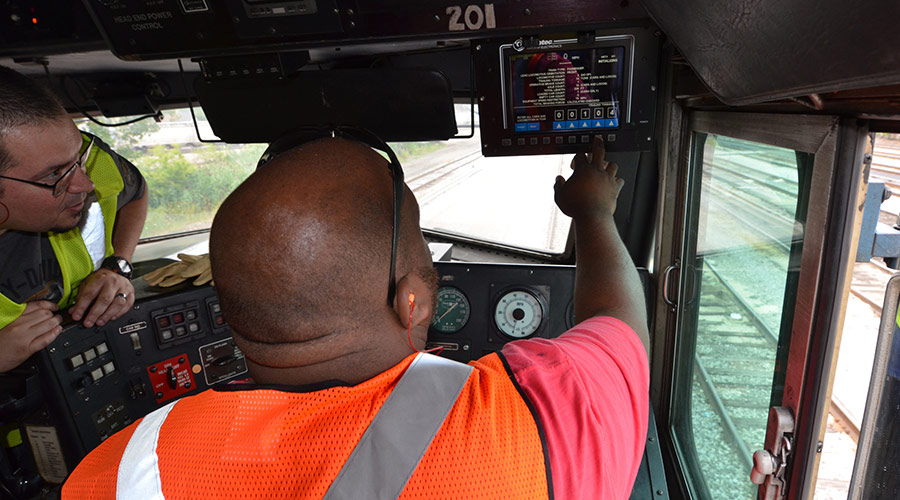Stay updated on news, articles and information for the rail industry
 railPrime
railPrime
April 2010
Rail News: Short Lines & Regionals
C&S Positive Train Control: A big task for small railroads
By Jeff Stagl, Managing Editor
The Federal Railroad Administration (FRA) estimates it will cost Class Is and commuter railroads more than $10 billion to implement and maintain positive train control (PTC) systems. Regionals and short lines also are facing a steep PTC price tag, one that will be difficult for them to pay given their limited resources.
Small railroads will spend about $13 million to install PTC devices on locomotives; $2 million to maintain the devices; $400,000 to install manual derailing equipment, or split derails, at diamonds; and $220,000 for work associated with speed restrictions, according to FRA estimates. However, the total cost likely will go up after the Class Is, Amtrak and commuter railroads submit their implementation plans to the FRA this month (documents are due April 16), and the 65 small railroads impacted by the federal mandate gain a better understanding of what they're required to do, says American Short Line and Regional Railroad Association (ASLRRA) President Richard Timmons.
The FRA's final implementation rule includes an exception that enables small railroads to operate non-PTC-controlled locomotives on PTC-equipped lines up to 20 miles. They also can exceed 20 miles until Dec. 31, 2020. But there are questions about how toxic inhalation hazard and passenger-rail traffic on regionals' and short lines' routes will come into play, says Timmons, adding that the short-line industry will continue to press the FRA and connecting railroads for answers.
"There are pieces and parts that bear discussion," he says.
If a regional or short line is a stand-alone company, the railroad would have to complete all necessary PTC work itself, says Timmons. A small railroad also could be part of an implementation plan submitted by a Class I, which could require certain equipment.
"Short lines fared reasonably well in the final rule, but a Class I can increase the safety requirement from what's stipulated in the rule," says Timmons.
In addition to questions about the scope of required PTC work, the short-line industry has queries about funding, including the availability of federal grants or loans, he says.
"The question is: Who pays for it?" Timmons asks.
Short-line tax credits — which would be extended until year's end according to a bill approved by the Senate and considered by the House last month — could be used to help fund PTC work, "but no one has tested that with the FRA," he says. The federal Railroad Rehabilitation and Improvement Financing (RRIF) loan program might be an option, as well.
"The RRIF program could help if there was a change to a very low interest rate, like 1 percent," says Timmons.
For now, regionals and short lines impacted by the mandate are trying to assess the cost and scope of PTC while they await clarifications and more information from Class Is, Amtrak, commuter railroads and the feds. But it might be months before their wait ends, several regional and short-line executives say.
"Now, there are more questions than answers," says Iowa Interstate Railroad Ltd. (IAIS) President and Chief Executive Officer Dennis Miller.
Nothing's for Certain
One major answer for IAIS will come from Amtrak, which might use a 100-mile portion of the regional's line between Wyanet, Ill., and Iowa City, Iowa, as part of its high-speed rail (HSR) plan. A connection to a BNSF Railway Co. line would be built in Wyanet, says Miller.
The national intercity passenger railroad plans to apply for federal dollars in the second round of HSR grants to help fund the plan; grants are expected to be awarded in late 2010.
If Amtrak pursues the HSR plan, "we would need PTC on the route," says Miller, who expects to have a better handle on PTC implications later this year or in early 2011.
In addition, implementation plans to be submitted this month by BNSF, Union Pacific Railroad and Metra could impact the more than 500-mile regional. Coupled with Amtrak-imposed work, any PTC requirements stipulated by those three railroads could hit IAIS hard in the pocketbook, says Miller.
"If PTC ends up costing us $10 million to $15 million, that's one year's worth of a capital program," he says.
Budget-busting Proposition
If PTC work costs the North Carolina Railroad Co. (NCRR) what's now estimated at $20 million, the short line would be straddled with a budget crisis.
"That would be two years of our revenues," says NCRR President Scott Saylor. "We wouldn't be able to do other projects."
The railroad manages a 317-mile corridor between Morehead City and Charlotte that's used by more than 60 Norfolk Southern Railway and eight Amtrak trains daily. Amtrak uses two-thirds of the corridor and NS — which operates Amtrak's trains under a long-term contract — has estimated it would cost $13 million to install PTC on the more than 200-mile segment. If NCRR has to implement the technology along the entire corridor, including a light-density segment, NS estimates it would cost $20 million, says Saylor.
"PTC is a good idea, it's just expensive," he says.
The entire route is part of a federally designated HSR corridor and North Carolina's HSR plan, so future federal grants might help NCRR fund PTC work.
"We won't know more until we hear from NS," says Saylor. "We'll see how the rule pans out and if federal funding is available."
Railroads need to be more vocal at the federal level about PTC's high costs, and its potential limitations on budgets and operations, says Steve Powell, senior vice president of the Buckingham Branch Railroad Co., which hosts Amtrak trains on a 125-mile, Orange-to-Clifton Forge, Va., portion of its 200-mile line. ASLRRA has been stressing those points in Washington, D.C., for some time, as has the rail industry, especially during the annual Railroad Day on Capitol Hill.
"Anyone looking at short lines and the requirements would see the devastating effect PTC would have on rail transportation in Virginia," says Powell.
The Buckingham Branch estimates it would cost $12 million to $17 million to install PTC — a "high price tag for running six Amtrak trains a week," says Powell.
"There's no way we can implement it. The cost would bankrupt us," he says. "We determined that if we used our Amtrak revenue to pay for it, without any interest or other funds, it would take us 150 years to pay for it. Our position is that if PTC is required on the line, Amtrak should implement it on our behalf."
The Rule's Not the Norm
Powell believes his railroad qualifies for a limited operating exception in the FRA's final rule that pertains to short-line operations on mainlines. The exception states that annual tonnage must be less than 15 million gross tons ("We're at 10 to 11 million gross tons," says Powell) and passenger trains must number no more than 12 per day ("We're at two trains every other day," he says).
But even if the short line files for an exception and the FRA approves it, the agency could require the Buckingham Branch to change certain operating practices, says Powell.
"And what if we exceed the 15 million gross tons in the years ahead — what then?" he asks. "The maintenance cost alone is unbelievable. We hope no bad decisions are made."
The Belt Railway Co. of Chicago and Indiana Harbor Belt Railroad Co. also are confronting cost and scope uncertainties associated with PTC. The Class Is could decide to require both railroads to do something, says Belt Railway President Patrick O'Brien.
The railway's board held a meeting in early March and determined that, according to how the final rule currently reads, the short line is not impacted by the rule, he says. However, that could change after the Class Is submit their implementation plans this month and railroads operating in Chicago discuss how to "map out" PTC through the area, says O'Brien.
The board will hold another meeting in early June, at which time Belt Railway executives should have a better understanding of how the rule impacts the railroad, he says.
Bridge Hangs in Balance
The New Orleans Public Belt Railroad Co. (NOPB) already knows how PTC will affect the short line, which operates about 25 miles of main track and 97 miles of yard track. NOPB needs to implement the technology on the Huey P. Long Bridge, which is used by the short line, BNSF, UP and Amtrak. The short line owns the 4.5-mile, double-tracked bridge, which accounts for only 10 percent of its system. NOPB maintains the railroad portion of the structure while the Louisiana Department of Transportation & Development maintains the roadway portion.
However, the short line hasn't determined a scope or cost yet for the project, which BNSF, UP and Amtrak would have to help fund because they use the bridge, says NOPB General Manager Jim Bridger. He hopes to have a better understanding of any PTC requirements in summer.
"We need guidance," he says. "We're finding our way along."
Many regionals and short lines are doing the same thing while they probe Class Is, Amtrak and the feds for more information.
"The first thing on the plate is the railroads submitting their implementation plans to the FRA," says ASLRRA's Timmons. "There's uncertainty now. But I think things will shake out relatively quickly."
One thing that's certain: The total cost facing all railroads will continue to climb as PTC is implemented, Timmons believes. As it stands now, Class Is, commuter railroads and small railroads probably will spend closer to $20 billion to install and maintain systems, construct diamonds, train T&E crews and complete other PTC-related work, he says.
"I'm basing my projection on my experience and non-analytical feeling that things end up costing thee or four times the estimates," says Timmons. "I've already heard that Class Is' and commuter railroads' costs have climbed to $14 billion."


 2025 MOW Spending Report: Passenger-rail programs
2025 MOW Spending Report: Passenger-rail programs
 Gardner steps down as Amtrak CEO
Gardner steps down as Amtrak CEO
 Guest comment: Oliver Wyman’s David Hunt
Guest comment: Oliver Wyman’s David Hunt
 Women of Influence in Rail eBook
Women of Influence in Rail eBook








